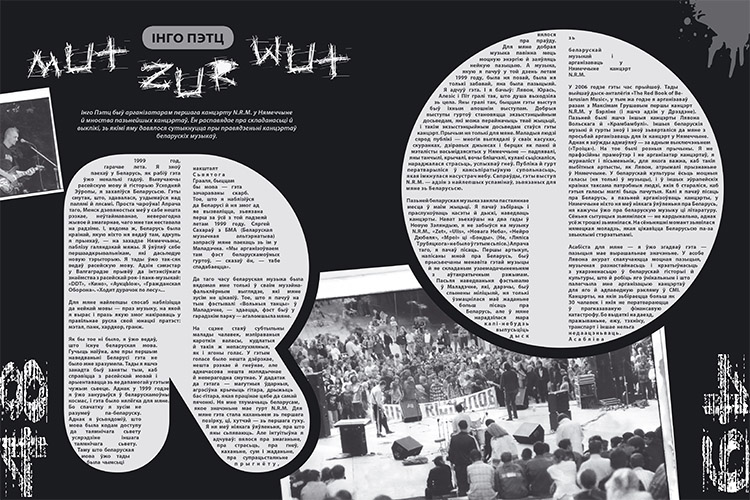
Аўтар: Volha Bubić, 02/09/2015 | ART project
20 YEARS LATER, or ОN CONTINUITY IN PHOTOGRAPHY BY
pARTisan #28’2015
«At the moment I represent the zero level of Belarussian identity».
Alaksandr Vieledzimovič, Belarusian photographer, one of «BY NOW» finalists
The state in which Belarusian photography finds itself nowadays is one of the most debated issues in the country’s cultural environment. The need to study the development and topical photographical trends has been repeatedly articulated in public discussions (for example, at the roundtable discussion «Reconstructing photographical history: from «Minsk school» to «By Now» generation»). Moreover, this problem is regularly dealt with in articles, albums and books. In this regard the publications of the album «New Wave» in the pАRТisan collection and the collection of essays «Creative Photography in Belarus. The Experience of Gallery of Visual Arts «NOVA» of the Belarusian Photographic Web Almanac PHOTOSCOPE.BY. 1996-2013» became significant events for the Belarusian critical community.

Alaksandr Vieledzimovič. Place
Exploring photography and establishing continuity trends are closely associated with the topic of cultural identity – the issue which still remains painful for us.
Photography has always been characteristic of such main functions as reality registration and the photographer’s existential search, and in this aspect it provides researchers with rich data for analysis. Certainly, it possesses a huge potential in finding answers to the questions about visual research traditions, as well as topics that remain in focus for decades and some features of collective unconscious which in their turn can form the basis of the Belarussian identity.
In regard to these questions «BY NOW» is a project of a particular interest. It was the result of the ambitious contest held in 2013 by the German curators Matthias Harder and Hans Pieler. Its main goal, articulated by the Belarusian photographer Andrei Liankievič who had a role of the project’s art manager, was in creating «a simple project on contemporary Belarusian photography», which would claim to reflect an intermediate «selection» or «a mosaic» of all that has been happening in Belarussian photography for the last decade. The significance of «BY NOW» is primarily linked with the fact that there are these 16 visual statements chosen by the curators that today and in the upcoming years would form in the minds of the Europeans an image about Belarus. The self-titled album which contains the contest’s photographic results can be freely purchased in Europe, whereas the exhibition of the participants’ works opened at «ifa-Gallery Berlin» in October, 2014.
To some extend «BY NOW» has become a symbol of young Belarusian photography having occurred from the point of view of marketing in time and in the right place. The name itself through its cunning multiple interpretations encoded in its English title ambitiously drives us to the need to reflect on everything that occurred within our visual field «by now», simultaneously suggesting a new topical perspective on the country with the geographical abbreviation of «BY». It seems to be a sort of logical coincidence that exactly twenty years ago, in October of 1994, «ifa-Gallery Berlin» already acted as a platform for the presentation to the general public a visual selection of the Belarusian reality. The exhibition brought together the works of young photographers, whereas the stimulus for those photographs to appear was largely provided by Valery Labko’s studio with this figure’s being a legendary personality, who had made an enormous contribution to the formation and development of the Belarusian photography of the 1980-1990s.
Looking through the album «Fotografie aus Minsk» which puts together the works of the heroes of the entirely different generation, a desire to raise once again a painful problem of the continuity in Belarusian photography which still makes many people dwell on it naturally appears. Thus, there comes a desire to compare through the materials provided by the two albums the questions the photographers in 1994 and 2014 were addressing, as well as the answers they formulated in their own creative projects.
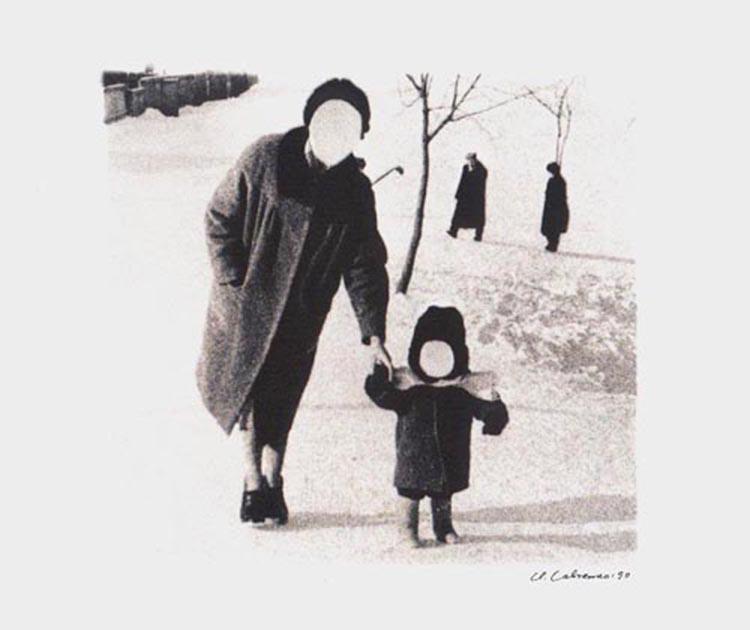
Ihar Saučanka. 12-90-4-2
24694 Bytes
Can we trace a certain continuity in Belarusian photography within the last twenty years? Or actually in the visual sphere we are also doomed to keep «resetting» everything over and over again, doomed to suffer from the eternal complex of those who reinvent the wheel?
FACELESS
In a broad sense an image or a description by artistic means of a person or a group of people who exist or existed in reality refer to the portrait genre in painting, photography and literature. Specialists in Culture Studies point out that in art the portrait assumes not only the reproduction of some external characteristics of an individual, but also revealing his/her unique components – a complete disclosure of the personality’s inner world. Comparing the photographs with people depicted in them in the albums «Fotografie aus Minsk» (1994) and «BY NOW» (2013) we can trace an interesting tendency.
In all the photographs of the 1994’s album there are people present, however in almost none of them the viewer is given a chance to give a closer look at a person portrayed. In the series made by Ihar Saŭčanka (Igor Savchenko), Siarhiej Kažamiakin (Sergey Kozhemyakin) and Uladzimir Parfianok we see only some parts of human figures, captured in unusual angles and/or extreme cropping. In Halina Maskalova’s (Galina Moskaleva) and Uladzimir Šachlevič’s (Vladimir Shachlevich) works the topic of the portrait is realized by means of duplicating the image, where the character’s integral identity is presented as if being assembled from pieces or through the repetition of the same shot. In addition, physical inability to see a person’s face makes play with the image of a mask (for example, by Uladzimir Parfianok): in the shots from the series «Persona Non Grata» one of the characters reads an issue of «The Soviet Culture» newspaper having his face covered by a gas mask, whereas a naked couple poses with their heads wrapped in a tissue which somehow seems to refer to a famous surrealistic plot of Rene Magritte’s. The young Belarussian photographers’ album continues the tradition of distancing themselves from «classical» portraiture. In Volha Sasnoŭskaja’s, Alaksiej Navumčyk’s and Siarhiej Hudzilin’s projects we find shots which are virtually identical with the abruptly cropped pictures from «Fotografie aus Minsk».
The portrait in its traditional sense tends to remain in commercial photography. In the album «Fotografie aus Minsk» this niche is taken by Siarhiej Kažamiakin’s series «Children’s Album», while «BY NOW» — by the photographs by Jaŭhien Kanaploŭ-Lejdzik «Fata-Morgana». Commenting on the idea that underlies the series in his interview for the site ZNЯТА Kažamiakin said: «A professional for whom photography is a craft takes pictures of children and creates entourage. I is some sort of a strange uniform that, to his own mind, must seem attractive to the client. Here very many things are mixed up – folklore, estrade, military uniform elements, Soviet emblems. In fact, his cultural background, tastes, stereotypes, ideas about beauty and many other things are revealed. All this kitsch is directed at the spectators. Another layer is revealed when you look at all the pictures together, at the «Children’s Album». There are some very little kids, there are those who a little bit older, there are the bigger ones, somewhere around. And you realize how a person is made to fit the society».
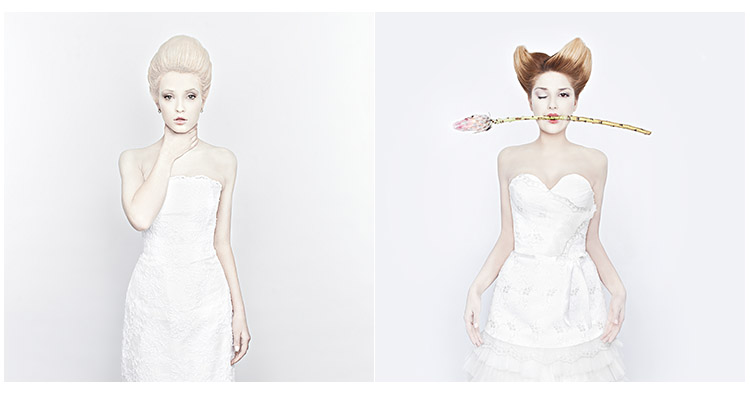
Jaŭhien Kanaploŭ-Lejdzik. Fata-Morgana
The portraits of the trio «Topless» band, which appear on the first pages of the «BY NOW» album are made in the same kitsch way, staged according to the ideas about what is tasty, sexy and attractive in the mass audience’s eyes. Despite the visible diversity in selecting his characters, the photographer Jaŭhien Kanaploŭ-Lejdzik continues the tradition of showing to his viewers impersonal insensible images. Being technically perfect, they fail to transmit even a hint at the real nature of the girls’ personalities. If to put aside the formal geographical aspect, we may claim that such images might have been made practically in any country of the world which follows the rules of commercial photography. In point of fact, they absolutely do not differ from those cropped photographs made by Siarhiej Kažamiakin or Ihar Saŭčanka. The viewer is again left face to face with the question about the nature of the characters portrayed.
One of the logical explanations of the tendency of depicting in Belarusian photography the faceless characters can be found in the thesis provided by the culturologist Boris Markov, who links the loss of the face with the identity loss that can occur both at the level of every particular individual and referring to the whole people. «Every person, every group or people should enjoy praising their outlook, their culture and customs, be proud of them in order not to lose themselves and not get dissolved in others, – wrote Markov in his book «Culture of Everyday Life», – The problems of the identity loss and preservation can be fully understood not so much at the level of ideology, but through psychology or even physiology of people. Identity is a psychosomatic condition; it includes not only the knowledge of who I am, but also a sense of confidence, pride and self—respect».
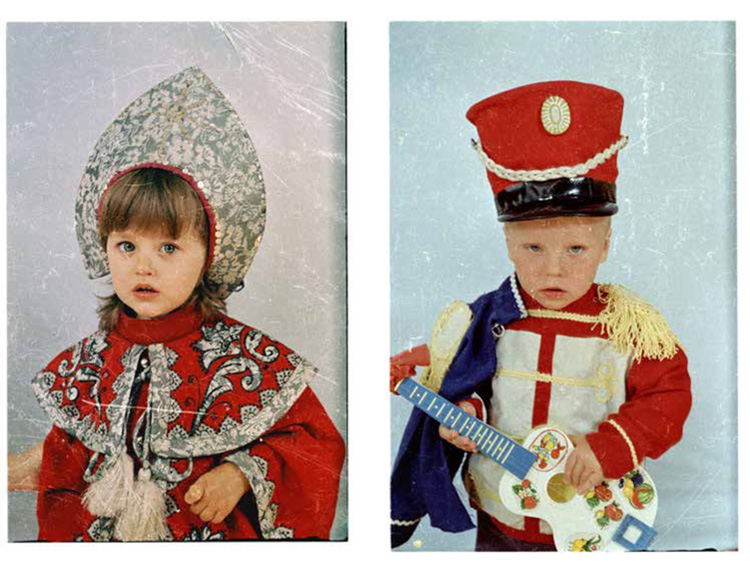
Siarhiej Kažamiakin. The Children Album
As we know, in this regard the Belarusians present a nation that is characterized by «the absence of distinct national and cultural forms» and by the uncertainly in establishing the dialogue with their own collective «self», which is manifested in the situation of bilingualism, a cautious attitude to their historical past and current heritage, as well as by the endless debate on which geopolitical camp to join. As we see, these mental specificities get reflected in the photographic traditions, too.
We either escape from the camera lenses or stick to the rules of the games imposed on us from the outside.
And, as a poetic refrain in the tendency of the presentation of an individual in Belarusian photography there stands out a philosophical formula of the Belarussian philosopher Valancin Akudovič. «I am not here».
NAMELESS SPACE
When comparing the albums with 20 years of distance between them, we can also give a closer look to the approach the Belarusian photographers use in capturing physical space around them. In photographing landscapes as well as in portraits, they miraculously manage to stick to the same line of namelessness and surrealism. It is enough to compare the series by Uladzimir Parfianok «La Musique Savante Manque a Notre Desir (Arthur Rimbaud)» found in the photobook «Fotografie aus Minsk» and the widely recognized young Minsk photographers’ Maksim Šumilin‘s (Maxim Shumilin) and Michail Leščanka’s (Michail Leschenko) style whose series were chosen to become a part of «BY NOW». Both visual selections reveal a calm, but persistent answer given to the reality by the authors who are dissatisfied with it. It is an attempt to escape into another universe found at the edge of the dream and the perception of the moment of now, the creation of the world of their own which is unlike everything that surrounds them.
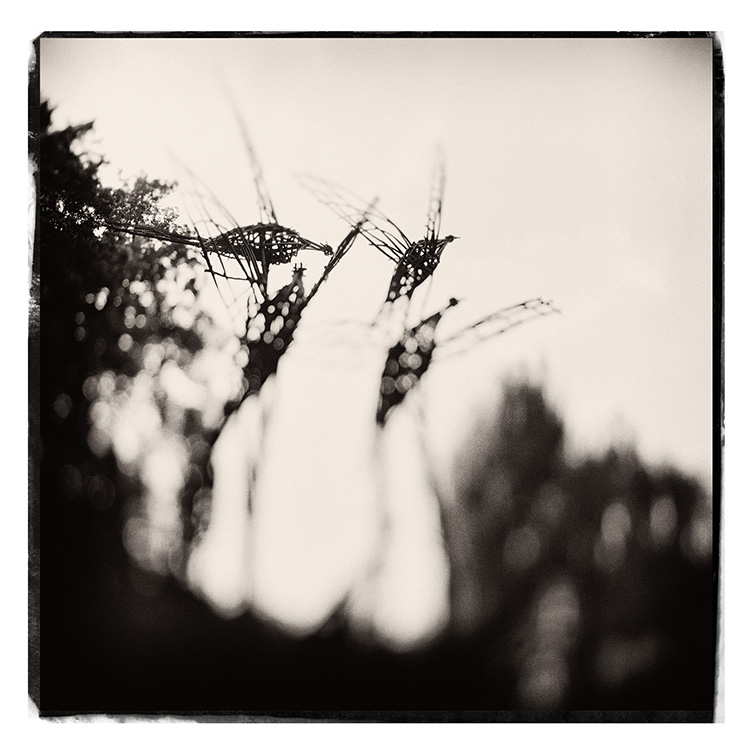
Michail Leščanka. The Garden
Commenting on the exhibition «The Garden» held by the tandem of Maksim Šumilin and Michaił Leščanka, the artist Sergey Shabohin wrote: «Looking at the photos from the series «The Garden» and some earlier works, you realize that they are deprived of any traces of modern civilization, of «time capsules» or any objects that characterize the place and time of the events captured. All the items and images are simple and recognizable, as if they existed forever. Everything has been made clear and dissolved in the shots, it is «the mythology of the ordinary», pure sincerity, simplicity and harmony. The photographers, as they state themselves, «are agents of some other larger irrational forces», so the role of intuition in their works comes to be so important».
Surrealism originated in Europe in the early XX century as the artistic minds’ reaction to the growing inhumanity and spiritual disharmony of the capitalist world. Searching for the «true reality» that would allow them to grasp their personal-sensual subjectivity and get liberated from the yoke of social pressure, artists proclaimed freedom and irrationality as their key values. However, if in the course of its formation, surrealism gradually ceased hunting for the uncontrolled subconscious, giving way to thoughtful clever experiments aimed at provocation of everyday notions, in case of Belarussian photography, it remains, in my opinion, closely connected to narcissism directed at the uniqueness of one’s proper serene universe.
Escape into themselves, planned by the surrealists as a first step towards the revolution, brought the authors into a cozy deadend, populated by lulling sirens. Again quoting Sergey Shabohin’s review to the project «The Garden», one of the photographer’s statements can be recalled: «Here, time stands still» — says Maksim Šumilin — «our entire creative process is like an escape to a paradise from the reality that surrounds us». So, impersonal representation of a man in Belarussian photography can be enriched by a similar characteristic but in terms to the view of the surrounding space, forming an overall picture of the total mental vacuum — a unique meaningful zero morpheme, which represents Belarus on the European stage. But is it really so? Looking at the photos on the pages of «BY NOW» and comparing the approaches of the young photographers with those of their predecessors, one can also discover a few new tones.
A DIFFERENT PERSPECTIVE
If not entirely new, then definitely just a different visual language can be traced in the series made by a representative of the young Belarusian photography Alaksandra Sałdatava (Alexandra Soldatova) «Holidays in the City», if to compare «BY NOW» content with the album «Fotografie aus Minsk». Alaksandra virtually turns out to be the only photographer out of 16 project’s participants to deal with the exploration of the Belarusian routine out of «the kitchen comfort zone». Her works reveal the topic of urban everyday life of an ordinary city dweller, showing him/her as an undemanding uninvolved observer of the country set in «stand by» mode.
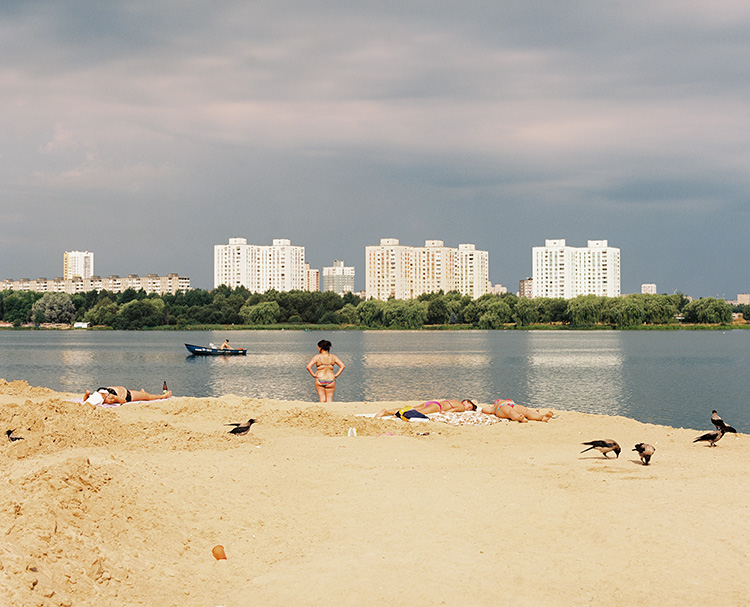
Alaksandra Sałdatava. Holidays in the City
Another extraordinary example is provided by the series «Private President» made by Siarhiej Hudzilin. There the provocative reporter of the «Naša Niva» newspaper handles the topic of the private and the public. Making use of the visual method of deconstruction, already popular in the 1990-s among some Belarusian photographers (such as, for example, Uladzimir Šachlevič, Vadzim Kačan), Hudzilin, he, nevertheless, manages to give a brand new look at the borders of distance and their forced transformation in the contemporary media society. In Siarhiej’s series the portrait of the President of Belarus is presented through a set of photo fragments made when photographing a TV screen. A paradox is formed: the leader who repeatedly mentions his closeness to the people actually does get closer to us, finding himself at a really «private» distance. However, the fact that we fail to recognize him, to have his face seen in the traditional meaning of the portrait genre, forms a vague, impersonal image composed from the fragments of the face, gestures and clothes attributes.
One more example of another perspective applied to a familiar topic is a project made by Andrei Liankievič, who works with the issue of the war past of the Belarusians. The author incorporates in his large-scale series about collective memory a bold combination of various methods which are seen as new for the visual field of Belarusian photography. Among them there are, for example, archive photographs and their rethinking in today’s realities, pseudo-documental staging and google technologies. Particularly noteworthy are his diptychs which include google-shots of the Belarusian streets named in honor of the Great Patriotic War heroes and their deliberately blurred archival portraits. Placing the images in this way, the photographer addresses the issue of their reality and their meaning in people’s collective consciousness, as well as the phenomenon of historical memory. What meaning do the names of Maria Melnikayte, Liliya Korostoyanova, Petr Masherov have for the Belarusians? A long time ago familiar names ceased to be associated with the deeds of the heroes who defended our Motherland, the photos of their faces do not trigger in our memories any clues. Computer images from Google-maps with gray asphalt and concrete lines crossing the snow-white page seem more real to us.
These authors take young Belarusian photography to a new level of development, offering a different perspective on familiar topics related to what might be called «Belarusian reality».
Answering the question about continuity in Belarusian photography of the last twenty years, I would like to argue the opinion given by the photographer Alaksandr Vieledzimovič that was chosed as the epigraph to this article. In the documentary film made by Maksim Bahdanovič about the participants of «BY NOW», Vieledzimovič reacts to the problem of continuity defining himself as a «zero identity level», noting that he is just starting to feel like «a person who somehow can associate himself with this country». Even if we do not take into consideration that in Culture Studies «zero human identity» actually stands for gender identity, we can agree that the existence of any culture is impossible without traditions, regardless of the fact whether we follow them consciously or not, when obtaining information from formal, structured sources, represented, for example, by educational programs, publications or exhibitions, or grasping it spontaneously, often even out of our control.
For something new to be born it is necessary to assimilate the outcomes of the previously performed activities. This general rule of development is also applicable to the sphere of culture. From scratch, devoid of any culture, it is impossible to create a new one. It is common knowledge that one cannot divide by zero, and impersonality in depicting people as well as conscious escape from reality seem to be full-fledged characteristics suggestive of the continuity in the Belarusian photographic tradition. Other features can be seen in our constant attention to the subject of bygone wars and our wish to play with the regime.
You cannot start every time from scratch, whatever personal spiritual quest we currently associate ourselves with at the moment.
Volha Bubič
Opinions of authors do not always reflect the views of pARTisan. If you note any errors, please contact us right away.




